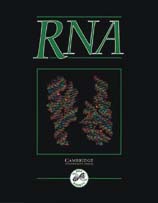Crossref Citations
This article has been cited by the following publications. This list is generated based on data provided by
Crossref.
Chen, Shuyan
Anderson, Karin
and
Moore, Melissa J.
2000.
Evidence for a linear search in bimolecular 3′ splice site AG selection.
Proceedings of the National Academy of Sciences,
Vol. 97,
Issue. 2,
p.
593.
Penalva, Luiz O. F.
Lallena, Maria José
and
Valcárcel, Juan
2001.
Switch in 3′ Splice Site Recognition between Exon Definition and Splicing Catalysis Is Important for Sex-lethalAutoregulation.
Molecular and Cellular Biology,
Vol. 21,
Issue. 6,
p.
1986.
Dietrich, Rosemary C.
Peris, Marian J.
Seyboldt, Andrew S.
and
Padgett, Richard A.
2001.
Role of the 3′ Splice Site in U12-Dependent Intron Splicing.
Molecular and Cellular Biology,
Vol. 21,
Issue. 6,
p.
1942.
Jurica, Melissa S
and
Moore, Melissa J
2002.
Capturing splicing complexes to study structure and mechanism.
Methods,
Vol. 28,
Issue. 3,
p.
336.
Matlin, Arianne J.
and
Moore, Melissa J.
2007.
Alternative Splicing in the Postgenomic Era.
Vol. 623,
Issue. ,
p.
14.
Bessonov, Sergey
Anokhina, Maria
Will, Cindy L.
Urlaub, Henning
and
Lührmann, Reinhard
2008.
Isolation of an active step I spliceosome and composition of its RNP core.
Nature,
Vol. 452,
Issue. 7189,
p.
846.
Konarska, Maria M
2008.
A purified catalytically competent spliceosome.
Nature Structural & Molecular Biology,
Vol. 15,
Issue. 3,
p.
222.
Gahura, Ondřej
Hammann, Christian
Valentová, Anna
Půta, František
and
Folk, Petr
2011.
Secondary structure is required for 3′ splice site recognition in yeast.
Nucleic Acids Research,
Vol. 39,
Issue. 22,
p.
9759.
Horowitz, David S.
2012.
The mechanism of the second step of pre‐mRNA splicing.
WIREs RNA,
Vol. 3,
Issue. 3,
p.
331.
Schellenberg, Matthew J
Wu, Tao
Ritchie, Dustin B
Fica, Sebastian
Staley, Jonathan P
Atta, Karim A
LaPointe, Paul
and
MacMillan, Andrew M
2013.
A conformational switch in PRP8 mediates metal ion coordination that promotes pre-mRNA exon ligation.
Nature Structural & Molecular Biology,
Vol. 20,
Issue. 6,
p.
728.
Hesselberth, Jay R.
2013.
Lives that introns lead after splicing.
WIREs RNA,
Vol. 4,
Issue. 6,
p.
677.
Mayerle, Megan
and
Guthrie, Christine
2016.
Prp8 retinitis pigmentosa mutants cause defects in the transition between the catalytic steps of splicing.
RNA,
Vol. 22,
Issue. 5,
p.
793.
Mayerle, Megan
Raghavan, Madhura
Ledoux, Sarah
Price, Argenta
Stepankiw, Nicholas
Hadjivassiliou, Haralambos
Moehle, Erica A.
Mendoza, Senén D.
Pleiss, Jeffrey A.
Guthrie, Christine
and
Abelson, John
2017.
Structural toggle in the RNaseH domain of Prp8 helps balance splicing fidelity and catalytic efficiency.
Proceedings of the National Academy of Sciences,
Vol. 114,
Issue. 18,
p.
4739.
Braun, Joerg E
Friedman, Larry J
Gelles, Jeff
and
Moore, Melissa J
2018.
Synergistic assembly of human pre-spliceosomes across introns and exons.
eLife,
Vol. 7,
Issue. ,
Maul-Newby, Hannah M.
Amorello, Angela N.
Sharma, Turvi
Kim, John H.
Modena, Matthew S.
Prichard, Beth E.
and
Jurica, Melissa S.
2022.
A model for DHX15 mediated disassembly of A-complex spliceosomes.
RNA,
Vol. 28,
Issue. 4,
p.
583.

